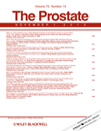Abstract
BACKGROUND
We recently established the rationale that NRBP1 (nuclear receptor binding protein 1) has a potential growth-promoting role in cell biology. NRBP1 interacts directly with TSC-22, a potential tumor suppressor gene that is differently expressed in prostate cancer. Consequently, we analyzed the role of NRBP1 expression in prostate cancer cell lines and its expression on prostate cancer tissue microarrays (TMA).
METHODS
The effect of NRBP1 expression on tumor cell growth was analyzed by using RNAi. NRBP1 protein expression was evaluated on two TMAs containing prostate samples from more than 1,000 patients. Associations with clinico-pathological features, the proliferation marker Ki67 and survival data were analyzed.
RESULTS
RNAi mediated silencing of NRBP1 expression in prostate cancer cell lines resulted in reduced cell growth (P < 0.05). TMA analysis revealed NRBP1 protein expression in benign prostate hyperplasia in 6% as compared to 60% in both, high-grade intraepithelial neoplasia and prostate cancer samples. Strong NRBP1 protein expression was restricted to prostate cancer and correlated with higher expression of the proliferation marker Ki67 (P < 0.05). Further, patients with strong NRBP1 protein expression showed poor clinical outcomes (P < 0.05). Analysis of matched localized cancer tissues before and after castration revealed that post-therapy-related repression of NRBP1 expression was significantly associated with better overall survival.
CONCLUSIONS
We demonstrate that expression of NRBP1 is up-regulated during the progression of prostate cancer and that high NRBP1 expression is linked with poor prognosis and enhanced tumor cell growth. Prostate 72:1678–1687, 2012. © 2012 Wiley Periodicals, Inc.




